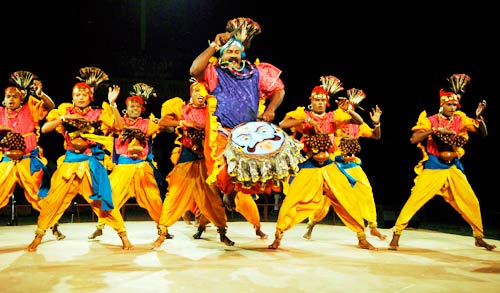The contribution of Kalahandi to the art and culture of Odisha is immense, and the most significant is the Ghumra dance. The dance has been instrumental in giving Kalahandi a special identity of its own. Though it is considered as the folk dance, characteristics of classical form prevail in every aspect of the dance—such as in the singer, dancer and in the beats of Nissan player. Researchers have also proved that classical dance forms, which are cited in Natyashatra, are found in this dance.
This is a group dance. It was performed by specific tribes such as Paika or Bankapaika, but now-a-days it is open to all. Nissan, Jhanj, Muhri, Mardal are some of the musical instruments accompanied with the dance.
Many researchers and historians have tried to unfold the history of this dance form. It is said that, it was the heroic dance of Lankagarh and was the war-musical instrument of Ravana. Another story depicts that while Devi Durga was fighting with Mahishasur, the followers of the goddess were playing many musical instruments – of which Ghumra was a part. Another story explains that master craftsman Chandradhwaja was the father of Ghumra and he kept it at Kuberpuri after creating it.
However, apart from the mythology, archaeological facts also suggest that the history of this dance is old. In the past, it was performed at many Shaktipitha of Dakshin Kosal. This dance was found in the excavation of Nehenar. Also, in 1005 A. D, while Lankeswari deity was brought to Jenabalipatna (modern Junagarh near Bhawanipatna), Ghumra was played to welcome the deity. The stone carving of Ghumra in the Bhimashwara temple, one of the oldest temples in Bhubaneswar, proves that the history of Ghumra is ancient.
Ghumra plays an important role at the time of different cultural and religious festivals in Kalahandi and Kosal region. It is customary to perform Ghumra in the festivals of different deities like Lankeswari, Manikeswari, Dakeswari, Dukuri Devi, Raktambari, Khmbeswari, Budharaja etc.
The popularity of this dance is not limited to Western Odisha region only; Ghumra dancers have displayed their skills and have taken the fame of the dance to many countries.

